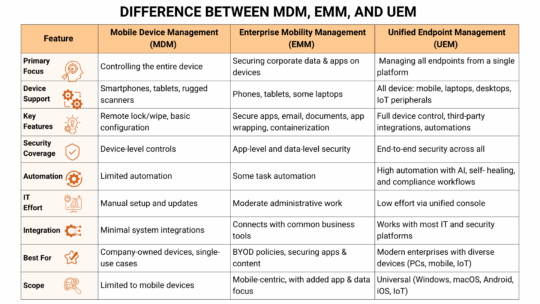Imagine your company has just switched to remote work. Everyone is excited; employees are using their own phones and new company tablets to work from anywhere. It feels flexible, modern, and full of possibilities.
But soon, some important questions pop up:
-
- What if someone loses their phone?
- How do we keep company data safe on all these devices?
- How do we make sure the right apps go to the right people?
This is where device management comes in. You might hear terms like MDM, EMM, and UEM, and yes, they can sound confusing. But think of them like upgrades:
-
- MDM is the basic version: It manages mobile devices.
- EMM adds more features: Like app and security controls.
- UEM is the full package: It manages all kinds of devices, not just phones.
Understanding MDM, EMM, and UEM helps your business stay secure while keeping things smooth and productive for your team. Let us understand the concepts in detail.
The Foundation: Mobile Device Management (MDM)
At the core of it, Mobile Device Management, or MDM, is the foundation. It is your devices' security sentry. MDM is all about managing the device itself. When you register a phone, tablet, or laptop into an MDM solution, your IT department gets control to be able to do things such as implement a password policy, remotely lock the device in case it's lost, or even wipe the device clean to prevent company data loss.
It is a strong weapon, but it has a specialized scope. Consider MDM like keeping a company car. You have control over who's driving it, you can monitor where it is, and you can remotely lock it if it's stolen. You don't necessarily have control over what's being placed in the glove box, though. Similarly, classic MDM is great for controlling the overall device but is less concerned with the individual applications and data on it. This is a great, budget-friendly option for companies deploying one type of device, such as a shipment of tablets to a delivery crew, where the device is dedicated to a single main use.
The Expanded Toolkit: Enterprise Mobility Management (EMM)
As the workplace grew more complicated, so did our requirements. Workers started leveraging a combination of personal and business devices, a practice referred to as Bring Your Own Device (BYOD). Overnight, the concept of a business having complete authority over a personal phone, from being able to erase family photos to work emails, became a top priority. That is when Enterprise Mobility Management, or EMM, came into the equation.
EMM is most easily conceived of as a set of tools that contains MDM but superimposes important additional layers on top of MDM. The greatest addition is that of containerization. Think of making a secure digital briefcase on an employee's personal phone. The company apps, emails, and documents reside within that briefcase. The IT team can secure and administer everything within that briefcase without accessing the employee's personal photos, social media apps, or messages.
This model transformed flexibility and security. Solutions to EMM typically encompass Mobile Application Management (MAM), in which the IT can deploy and manage certain business applications, and Mobile Content Management (MCM), which protects firm files and ensures they are only accessed via approved apps. While MDM is managing the whole car, EMM is managing the precise firm-owned cargo in it, no matter whose car it's traveling in.
The Unified Solution: Unified Endpoint Management (UEM)
These days, our definition of a "device" extends far beyond mobile phones and tablets. We use laptops, desktops, and even Internet of Things (IoT) sensors, anything that is an endpoint requiring management. Managing multiple systems for computers and mobile devices is cumbersome and leaves security holes.
This leads us to today's norm: Unified Endpoint Management, or UEM. A UEM platform is what comes next after EMM. It's a single, unified solution that provides your IT organization with one pane of glass through which to monitor and manage all endpoints within your organization. From the deployment of an operating system update to a desktop in the office to the deployment of a new application to a mobile device on the other side of the world to setting up an IoT device on the shop floor, it can all be achieved from one console.
The primary driver of the transition to UEM is simplicity and end-to-end security. It is not merely a trend but rather a reaction to a more sophisticated digital age.
Difference between MDM, EMM, and UEM
How to Choose the Best Mobility Solution for Your Business
Then, with these three choices, how do you select the best one? The solution isn't in which acronym is better; it is in which one is better for your company at this moment.
Begin by asking some easy questions. What kinds of devices are your staff members using? Are they predominantly company-owned, or is BYOD prevalent? Do you have to control only mobile devices, or also laptops and desktops? What is your main goal? Is it merely to lock down devices or to provide a genuinely flexible and productive mobile workforce?
For a small business with a straightforward implementation of company phones, a bare-bones MDM may be adequate. An expanding company welcoming BYOD will definitely require the sophisticated control of an EMM platform. But for most established businesses already operating in today's world, it is the best forward-looking and sensible option to invest in a UEM solution. It brings your tools together, streamlines IT management, and offers a secure foundation that will expand with your business, whatever new technology is on the horizon.
Getting to the right mobility solution starts with getting to know the landscape. Knowing the unique roles of MDM, EMM, and UEM gives you the confidence to proceed, knowing your business will be both secure and future-ready.
To learn more such insightful blogs, visit WisdomPlexus!
FAQs
1. What are MDM, EMM, and UEM?
Ans: MDM (Mobile Device Management) assists in managing and securing work devices such as phones and tablets.
EMM (Enterprise Mobility Management) includes additional features such as managing apps, data, and user access.
UEM (Unified Endpoint Management) is the latest. It controls all kinds of devices (phones, laptops, and desktops) from a single location.
2. Is UEM the same as MDM?
Ans: Not exactly. UEM incorporates MDM but does more; it can handle numerous types of devices, not only mobile ones.
Recommended For You:
Importance of Mobile Device Management (MDM) Solutions: Everything You Need to Know





